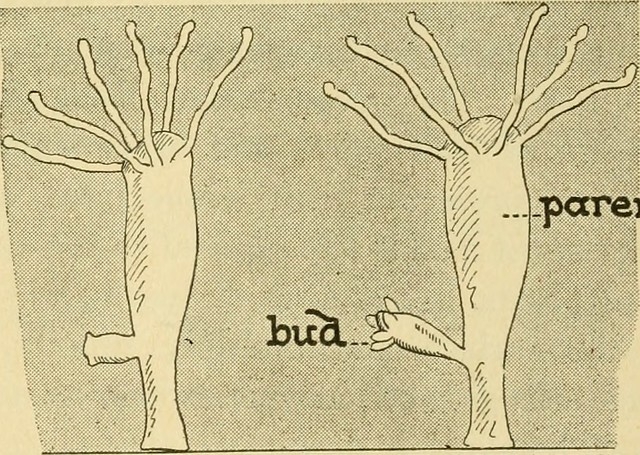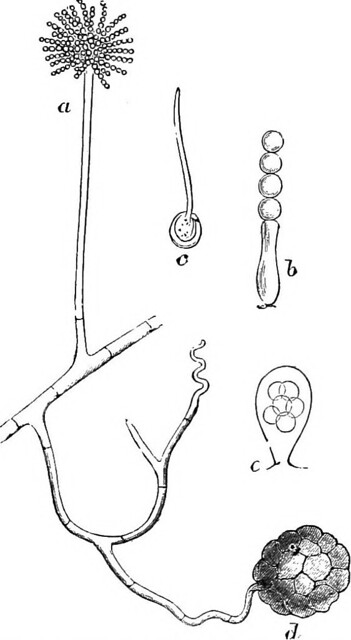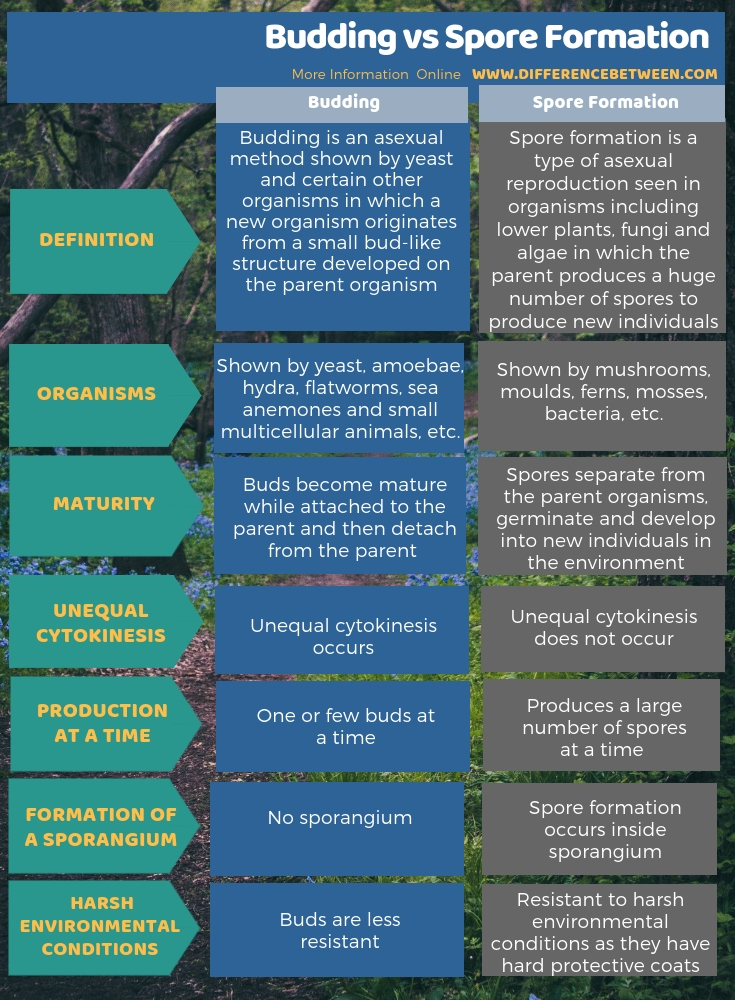Difference Between Budding and Spore Formation
Table of Contents
The key difference between budding and spore formation is that budding is a type of asexual reproduction in which a new organism originates from a small bud-like structure developed on the parent organism, while the spore formation is a form of asexual reproduction in which new individuals originate directly from the spores of the parent.
Budding and spore formation are two different asexual reproduction methods. Both, the budding and spore formation involve a single parent. Hence, there is no genetic material mixing or exchange. That is why the offspring produced through budding and spore formation are genetically identical to their parent organism.
CONTENTS
1. Overview and Key Difference
2. What is Budding
3. What is Spore Formation
4. Similarities Between Budding and Spore Formation
5. Side by Side Comparison – Budding vs Spore Formation in Tabular Form
6. Summary
What is Budding?
Budding is one of the asexual reproduction methods shown by certain organisms such as fungi, certain plants, and sponges like Hydra. It is a common asexual mode of reproduction in unicellular fungi such as yeasts. Budding initiates with the replication of the parent cell genome. Then a bud-like outgrowth forms on the parent organism as a result of cell division. After that, it enlarges and receives a nucleus from the parent. The next process that occurs is unequal cytokinesis, which gives rise to a daughter cell or a bud. The developed bud matures while attaching to the parent organism. Later it detaches from the parent cell and becomes a new individual that is genetically identical to its parent. In some organisms, these buds can remain attached to the parent cell for a long time until the development of a chain of buds called pseudomycelium.

Figure 01: Budding
Budding is somewhat a similar mechanism to binary fission in bacteria. However, unlike binary fission, budding involves an unequal division of the cytoplasm.
What is Spore Formation?
Spore formation is another form of asexual reproduction observed in organisms including lower plants, fungi and algae. Spores are produced by the parent organism. Then the spores germinate and eventually develop into new organisms that are genetically similar to the parent. Sporogenesis is the process that forms spores via mitosis. Haploid spores produce the gametophyte generation in plants. These asexual spores differ from the gametes that develop during sexual reproduction. In fungi and some algae, true asexual spores are produced as a mode of asexual reproduction.

Figure 02: Spore Formation
These spores are tiny, lightweight structures that have thick walls to protect themselves from harsh environmental conditions. Most of these spores are able to disperse by the wind. Unlike in budding, the parent organism produces a huge number of spores at a time.
What are the Similarities Between Budding and Spore Formation?
- Budding and spore formation are two types of asexual reproduction methods.
- Hence, gamete formation and fertilization do not occur in both types.
- Both cases involve a single organism or a parent.
- Also, the offspring is genetically identical to that of the parent in both methods.
What is the Difference Between Budding and Spore Formation?
During budding, buds or outgrowths develop from the parent organism while attaching to it. But, during the spore formation, the parent produces and releases spores to produce new individuals. So, this is the key difference between budding and spore formation.
The below infographic summarizes the difference between budding and spore formation in a tabular form.

Summary – Budding vs Spore Formation
Budding is an asexual reproduction method which produces new individuals from buds or outgrowths derived from the parent organism. Meanwhile, spore formation is another form of asexual reproduction which produces new individuals directly from the spores produced by the parent. Therefore, this is the key difference between budding and spore formation. However, since both types are asexual reproduction methods, they produce offspring that is genetically identical to the parent.
Reference:
1. “Asexual Reproduction.” Wikipedia, Wikimedia Foundation, 9 July 2019, Available here.
Image Courtesy:
1. “Image from page 252 of “Advanced biology” (1929)” By Internet Archive Book Images (No known copyright restrictions) via Flickr
2. “Image from page 210 of “Fungi; their nature, influence, and uses;” (1888)” Internet Archive Book Images (No known copyright restrictions) via Flickr
ncG1vNJzZmivp6x7pbXFn5yrnZ6YsqOx07CcnqZemLyue8OinZ%2Bdopq7pLGMm5ytr5Wau26u1J2boqaXYq6vsIysp6iqlWKzsL7Mmquip55k